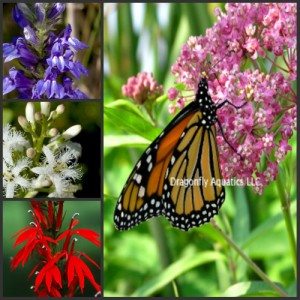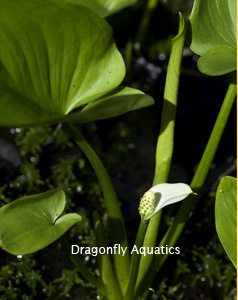I'm not certain of the identity of this butterfly. I thought perhaps it was a male Eastern Tiger Swallowtail. I'm really not certain, although it sure liked my dwarf crab-apple tree. It came back day after day.....I'm thinking it was the same one.
I know we don't want to think about it but it won't be long and fall will be here and we all know what comes next.....its time for us to be thinking about taking the extra care with our pond plants to make them comfortable for the winter cold. I've noticed the butterflies aren't as plentiful as they had been but occassionally I'm able to catch one.
HARDY BOG/MARGINAL PLANTS
Once your hardy marginal plants begin to brown, usually after the first hard frost, prune back excess foliage and discard any decaying material, so it does not compromise the water quality over the winter months. Potted bog plants such as Pickeral, Thalia Dealbata, and Japanese Variegated Iris should be placed at a sufficient depth to avoid freezing the crown of the plant. Most of the other hardy bog plants can be left as they are and will return the following spring.
Tropical Bog Plants
Many of the tropical bog plants will winter well indoors in a sunny window or with a grow light. They do not need to be submerged in water. Keep the soil constantly moist by placing the potted plants in a tray of water.
 I've been wanting to write something on this subject for some time now. Finally, I have a bit of time to address the subject of water depth for bog plants and marginal plants. Simply put, bog plants like their "feet" wet. Translation....roots and soil moist at all times. When the plants are first planted, this is especially important. Many of the bog plants will take deeper water as they mature and spread. But, when you first receive your bog plants, you will have better success if you place them where there is no more than a half inch or less of water above the soil line. Think of the marshes and swampy areas, you have passed while traveling down the road. These natural reservoirs, fill during the rainy season and will dry out during dry spells. The plants adjust to the varying water depth and grow and spread rapidly. If you have a question on a particular plant, just ask and we will be happy to help you plant and grow beautiful marginal and bog plants.
I've been wanting to write something on this subject for some time now. Finally, I have a bit of time to address the subject of water depth for bog plants and marginal plants. Simply put, bog plants like their "feet" wet. Translation....roots and soil moist at all times. When the plants are first planted, this is especially important. Many of the bog plants will take deeper water as they mature and spread. But, when you first receive your bog plants, you will have better success if you place them where there is no more than a half inch or less of water above the soil line. Think of the marshes and swampy areas, you have passed while traveling down the road. These natural reservoirs, fill during the rainy season and will dry out during dry spells. The plants adjust to the varying water depth and grow and spread rapidly. If you have a question on a particular plant, just ask and we will be happy to help you plant and grow beautiful marginal and bog plants.

![]() Arrowhead plants are one of the easiest pond plants to grow. Whether in your natural pond, water garden pond or container water garden, they contribute much to the landscape with their clean, geometric foliage and delicate small white flowers. These pond plants are highly recommended for your pond edge. They require Sun to Part Shade and will tolerate cold temperatures. Hardy Zones 3 to 11. Arrowhead plants like water depth from moist soil to 2 inches overall, but certain varieties will tolerate deeper water.
Arrowhead plants are one of the easiest pond plants to grow. Whether in your natural pond, water garden pond or container water garden, they contribute much to the landscape with their clean, geometric foliage and delicate small white flowers. These pond plants are highly recommended for your pond edge. They require Sun to Part Shade and will tolerate cold temperatures. Hardy Zones 3 to 11. Arrowhead plants like water depth from moist soil to 2 inches overall, but certain varieties will tolerate deeper water.
Their clean, geometric foliage and delicate white tiny flowers contribute a nice focal point to your water feature. Named for the shape of their leaves, arrowheads are easy pond plants to grow at the pond edge. The foliage may be narrow or broad, depending on which arrowhead you select, some even having lobed leaves. Their flowers appear first in June and reoccur throughout the summer.
The most common is the Arrowhead ( Sagittaris latifolia). It has arrowhead shaped leaves and produces a tiny white flower with yellow centered blooms and grows 12 - 20 inches high with a running spread. Hardy zones 3-11. The common arrowhead can take deeper water depth. Anywhere from moist soil to water 6 inches or more deep. Its leaves will even grow submerged.
Double-flowering Arrowhead (Sagittaria japonica) is very similar to the common arrowhead but produces a double white flower, resembling a tiny white rose. This plant grows to 2 ft tall. Hardy zones 3-11.
"Silk Stocking" Arrowhead (Sagittaria aistralis 'Benni") has striking, variegated maroon leaves. Clusters of tiny white, yellow centered flowers appear throughout the summer. It will grow to 2 ft. tall. The new growth of this arrowhead appears red and the older foliage looks smokey with a red overlay. Hardy in Zones 5-11.
Variegated Arrowhead (Sagittaria graminea 'Crushed Ice') is a distinctly variegated leaf. It has cream white blotches on each slightly twisted leaf and blooms white flowers in clusters with yellow centers. Grows to 12" to 24" tall and is hardy in Zones 5-11. It will grow in most soil to submerged in up to 5 ft. of water. A very striking plant.
Arrow Arum (Peltandra virginica) isn't an arrowhead but is very similiar. The plant forms a dense clump as do the arrowheads. Grows to about 24" high and can spread to 24" wide. A very light green to white flower will appear resembling a jack-in-the-pulpit. It takes moist soil or water to 6 " deep or more in sun to part shade. Hardy Zones 5-9. Shown in picture.
Purchase arrowhead,crushed ice,arrow arrum, here.